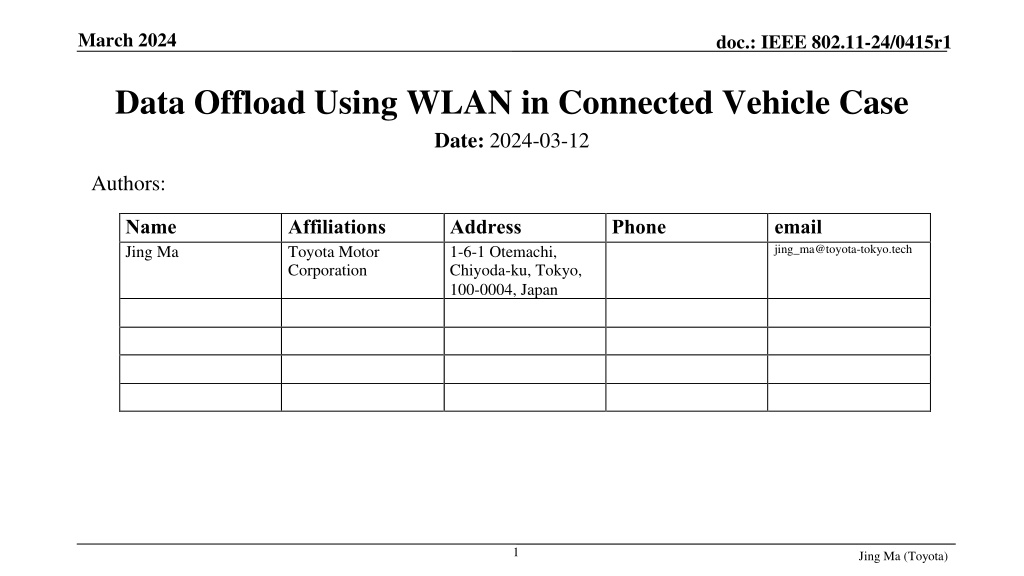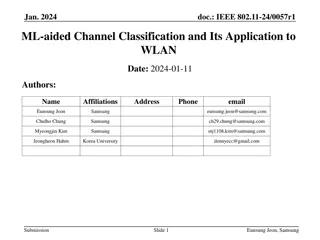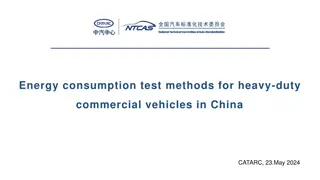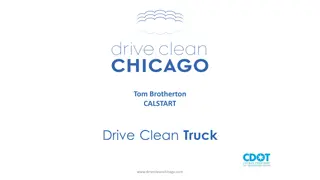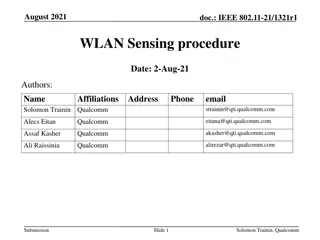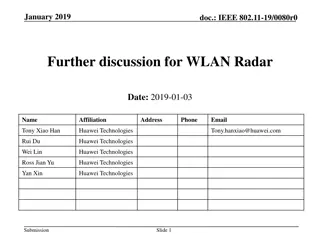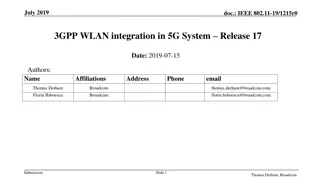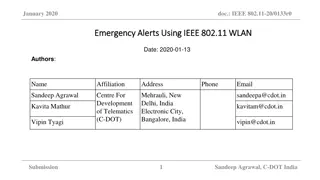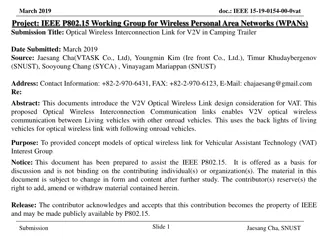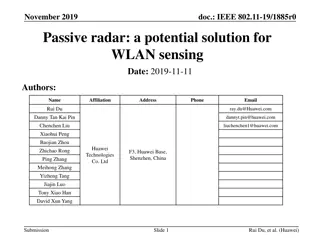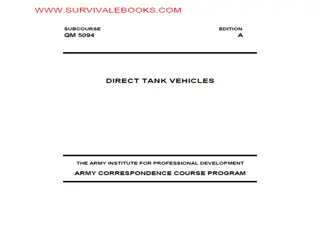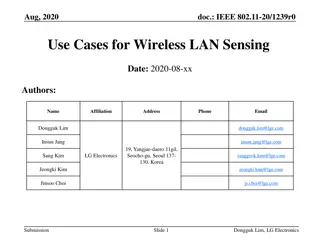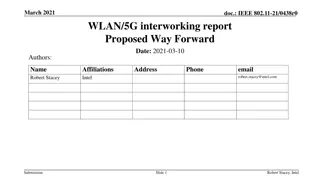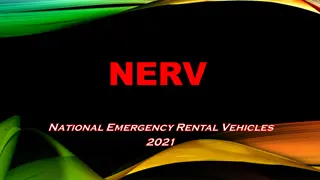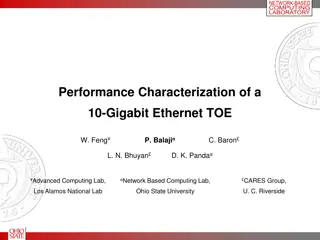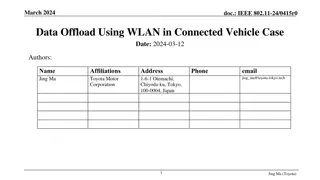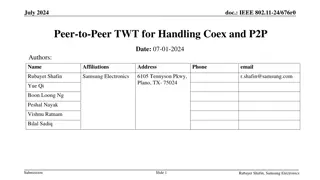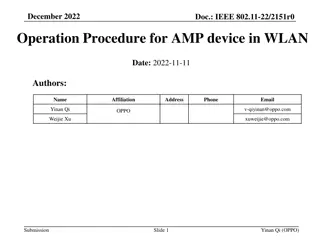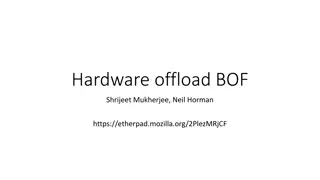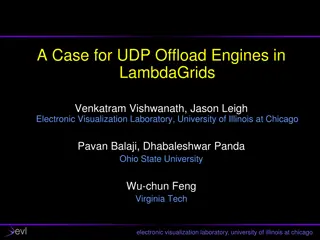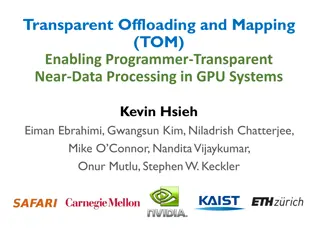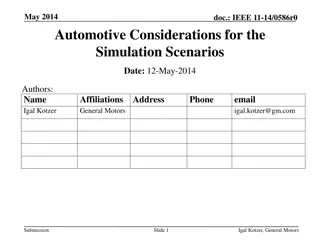Data Offload Using WLAN in Connected Vehicles
The document discusses the need for data offloading from cellular networks to WLAN in connected vehicles to address overwhelmed cellular capacity and reduce costs. It highlights the challenges and gaps in current standards like IEEE 802.11u, emphasizing the importance of Wi-Fi infrastructure for connected vehicles. With the global connected vehicle market forecasted to grow significantly, efficient data offloading strategies using WLAN are crucial for supporting various automotive services including large file transfers, media streaming, cloud services, and software updates.
Download Presentation

Please find below an Image/Link to download the presentation.
The content on the website is provided AS IS for your information and personal use only. It may not be sold, licensed, or shared on other websites without obtaining consent from the author.If you encounter any issues during the download, it is possible that the publisher has removed the file from their server.
You are allowed to download the files provided on this website for personal or commercial use, subject to the condition that they are used lawfully. All files are the property of their respective owners.
The content on the website is provided AS IS for your information and personal use only. It may not be sold, licensed, or shared on other websites without obtaining consent from the author.
E N D
Presentation Transcript
March 2024 doc.: IEEE 802.11-24/0415r1 Data Offload Using WLAN in Connected Vehicle Case Date: 2024-03-12 Authors: Name Jing Ma Affiliations Toyota Motor Corporation Address 1-6-1 Otemachi, Chiyoda-ku, Tokyo, 100-0004, Japan Phone email jing_ma@toyota-tokyo.tech 1 Jing Ma (Toyota)
March 2024 doc.: IEEE 802.11-24/0415r1 Abstract The market for connected vehicles is grow rapidly, and vehicles are becoming large producers and consumers of data Currently, connected vehicles are exclusively relying on cellular networks, which have overwhelmed the cellular capacity and is posing significant costs. Hence, offloading data from cellular to WLAN is crucial for connected vehicles. Current solutions such as IEEE 802.11u do not fully support the connected vehicle s data offloading case For the connected vehicle case, it is important to discuss and address the new challenges for supporting data offload using WLAN to complement cellular connectivity To support connected vehicles, it is essential to understand these challenges and identify the gaps in the current IEEE standards 2
March 2024 doc.: IEEE 802.11-24/0415r1 Background Global connected vehicle market size is forecast to reach US$ 198 B, with vehicles transferring approximately 100 petabytes of data monthly to the cloud 3 Jing Ma (Toyota)
March 2024 doc.: IEEE 802.11-24/0415r1 Motivation Connected vehicles have become large procurers and consumers of data - Data transmission for automotive services may be data-intensive, computation-intensive, and delay-sensitive Connected vehicles exclusively rely on cellular network, which is overwhelming the cellular capacity and is posing significant costs. As such, Wi-Fi data offloading is crucial for connected vehicles Wi-Fi infrastructures are increasingly getting deployed across major metros Home Wi-Fi network Provider-managed Wi-Fi network Low cost Provider-managed WiFi services are marketed as a perk attached to the home-Internet contract 4
March 2024 doc.: IEEE 802.11-24/0415r1 Data offload using WLAN When vehicles stop at home, gas/charging station, or pass roadside infrastructure such as street poles, vehicles connect to WLAN to offload vehicular data 10m/s Wi-Fi 100m Vehicles connect to a secured and stable home WLAN for long enough time for - Large File Transfers - Streaming media - Cloud backup and sync - Software update Vehicles connect briefly to WLAN mounted at roadside infrastructure when passing by for - Local information advertisement - Non-critical notifications - Non-real-time delivery Vehicles connect to gas/charging station s WLAN temporarily during its short stop for - Remote diagnostics - Non-real-time software updates - Location-based services 5
March 2024 doc.: IEEE 802.11-24/0415r1 Current offload solutions IEEE 802.11u-based solution makes connecting to WLAN easier and secure[2-3] Network discovery - Discover and gather information of available Wi-Fi networks before connecting (ANQP, beacon enhancements) Automatic network selection - Devices automatically select and connect network without user intervention Secure authentication and access - Pre-configured credentials for automatically authentication - Support secure authentication methods like EAP 6 Jing Ma (Toyota)
March 2024 doc.: IEEE 802.11-24/0415r1 Requirements Fast association & authentication protocol is essential. Currently, authentication & association setup may take a few seconds to complete, which poses challenges in the case where a connected vehicle has a limited time window during which it can establish a connection (e.g. only attaching to an AP for 10s) Reducing handover complexity/time is crucial. A connected vehicle in high-speed motion cause excessive handovers, introducing complexities and potential disruptions in data transmission Optimized roaming algorithms are necessary - Urban Wi-Fi environments may exhibit intermittent connectivity, leading to potential disruptions in data transmission - - 7 Jing Ma (Toyota)
March 2024 doc.: IEEE 802.11-24/0415r1 Requirements Network selection and prioritization - Balancing cost-effectiveness (connected vehicle data plans vs. Wi-Fi infrastructure investments) with network performance being key. Maintaining continuity of a communication session - Handover interruption, authentication & authorization delay and so on cause failure or interruption in connectivity and accordingly session disruption and data loss - Session continuity management such as some support from high layer is needed 8 Jing Ma (Toyota)
March 2024 doc.: IEEE 802.11-24/0415r1 Summary Data offload using WLAN for connected vehicle is introduced Current solutions such as IEEE802.11u do not fully support the connected vehicle case which introduces new challenges Association & Authentication latency, handover complexity, intermittent connectivity and so on Help is needed to address challenges for supporting smooth data offload using WLAN to complement cellular connectivity for connected vehicle case Next Steps Gap analysis between the requirements for data offload to WLAN in connected vehicle case and current IEEE specifications Proposing to form a TIG group to investigate solutions to bridge the gaps 9 Jing Ma (Toyota)
March 2024 doc.: IEEE 802.11-24/0415r1 References [1] GSMA. (2012). 2025 Every Car Connected. Retrieved April 3, 2023 [2] WiFi Alliance, Passpoint Specification", 2022. [3] IEEE 802.11u-2011 [4] F. Yang, etc., Revisiting WiFi offloading in the wild for V2I applications , Computer Networks, vol. 202, p. 108634, Jan. 2022 10 Jing Ma (Toyota)
